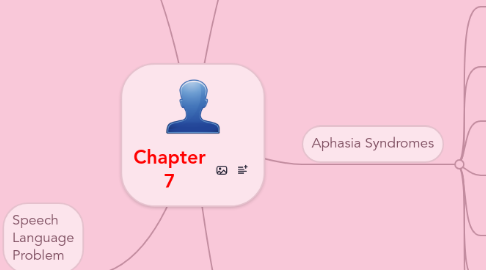
1. Stroke
1.1. Types of Strokes
1.2. Ischemic Stroke- When the blood supply to the brain is inhibited because of a blockage.
1.3. Thrombosis or Embolism Stroke- Occurs when plaque builds up in an artery or when a piece of accumulated plaque breaks off and blocks an artery.
1.4. Hemorrhagic Stroke- Occurs when an artery or blood vesssel ruptures and excessive amounts of blood enter the brain.
2. Speech Language Problem
2.1. Agrammatism- Broca's aphasia, transcortical motor aphasia.
2.1.1. They leave out grammatical markers in sentences and phrases, including verb inflections, articles, and prepositions.
2.2. Anomia- Broca's aphasia, transcortical motor aphasia, global aphasia, Wernicke's aphasia, conduction aphasia, transcortical sensory aphasia, anomic aphasia.
2.2.1. They have the inability to come up with words or names of items in spontaneous conversation or in structured naming tasks.
2.3. Telegraphic Speech- Broca's Aphasia, Transcortical motor aphasia.
2.3.1. Their phrases and sentences are made up of mostly content words with function words omitted.
2.4. Paraphasias- Transcortical motor aphasia, Wernicke's aphasia, transcortical sensory aphasia.
2.4.1. They substitute one word for another.
2.5. Jargon- Wernicke's aphasia.
2.5.1. They produce language that is meaningless and may run on and on.
2.6. Neologisms- Wernicke's aphasia.
2.6.1. When they make up a new word.
2.7. Effortful articulation- Broca's aphasia, global aphasia.
2.7.1. When their speech seems physically laborious, often accompanied by reduced phrases or sentence length.
2.8. Initiation difficulties- Transcortical motor aphasia, global aphasia.
2.8.1. When they have great difficulty or even enability to initate speech.
2.9. Comprehension deficits- Wernicke's aphasia, transcortical sensory aphasia.
2.9.1. When there is an inability to understand language.
2.10. Impaired repetition- Global aphasia, Wernicke's aphasia, conduction aphasia.
2.10.1. Inability to repeat sounds, words, or phrases.
3. Aphasia
3.1. A language disorder that is acquired sometime after an individual has developed language competence.
3.2. A disturbance in the language system after language has been established or learned.
3.3. Results from neurological injury to the language-dominant hemisphere of the brain.
3.4. Includes disturbances of receptive or expressive abilities for spoken and written language.
4. Aphasia Syndromes
4.1. Broca's Aphasia Syndrome-Lesion on the frontal lobe.
4.1.1. People who have this are nonfluent, they have effortful articulation, telegraphic speech, short phrases, impared prosody, and apraxia of speech.
4.1.1.1. Their language and auditory comprehension is fair to good.
4.2. Transcortical Aphasia Syndrome- Lesion on the prefrontal cortex.
4.2.1. People who have this are nonfluent, they have difficulty initiating speech, paraphasias, short utterances, and good repetition.
4.2.1.1. Their language and auditory comprehension is good.
4.3. Global Aphasia Syndrome- Lesions are on multiple lobes.
4.3.1. People who have this are nonfluent, they have delayed or no speech initation and output, naming and word finding problems.
4.3.1.1. Their language and auditory comprehension is poor.
4.4. Wernicke's Aphasia Syndrome- Lesion on the temporal lobe.
4.4.1. People who have this are fluent, and have meaningless speech and jargon, paraphasias, and naming difficulties.
4.4.1.1. Their language and auditory comprehension is poor.
4.5. Transcortical Sensory Aphasia Syndrome- Lesion is on the Parieto-occipital region.
4.5.1. People who have this are fluent, they have meaningless speech and jargon, paraphasias, and naming difficulties.
4.5.1.1. Their language and auditory comprehension is poor.
4.6. Conduction Aphasia Syndrome- Lesion on the arcuate fasciculus.
4.6.1. People who have this are fluent, they have imitation problems, naming difficulties, normal prosody and articulation.
4.6.1.1. Their language and auditory comprehension is fair to good.
4.7. Anomic Aphasia Syndrome- Lesion on the angular gyrus.
4.7.1. People who have this are fluent, and they have word-finding problems.
4.7.1.1. Their language and auditory comprehension is fair to good.
5. Acquired Disorders
5.1. Right-hemisphere Dysfunction
5.1.1. Causes- Stroke, illness, disease
5.1.1.1. Neurological damage to brain tissue in the right hemisphere due to loss of nutrients and oxygen to the brain.
5.1.1.1.1. Causes: Lack of attention to the left side of the body, difficulty recognizing faces, compromised pragmatics, wordy expressions
5.2. Traumatic Brain Injury
5.2.1. Causes- Motor vehicle accident, fall, recreational sports accident, act of violence
5.2.1.1. Neurological damage to the brain tissue due to closed or open head injrury.
5.2.1.1.1. Causes: possible significant personality changes, widespread language expression and comprehension problems
5.3. Dementia
5.3.1. Causes- Neurological diseas, multiple strokes
5.3.1.1. Gradual onset of declines in cognitive, language, and daily living functions due to progressive central nervous system dsysfunctions.
5.3.1.1.1. Causes: Memory impairment, impairment in cognitive skills, presence of aphasia, apraxia, or agnosia
